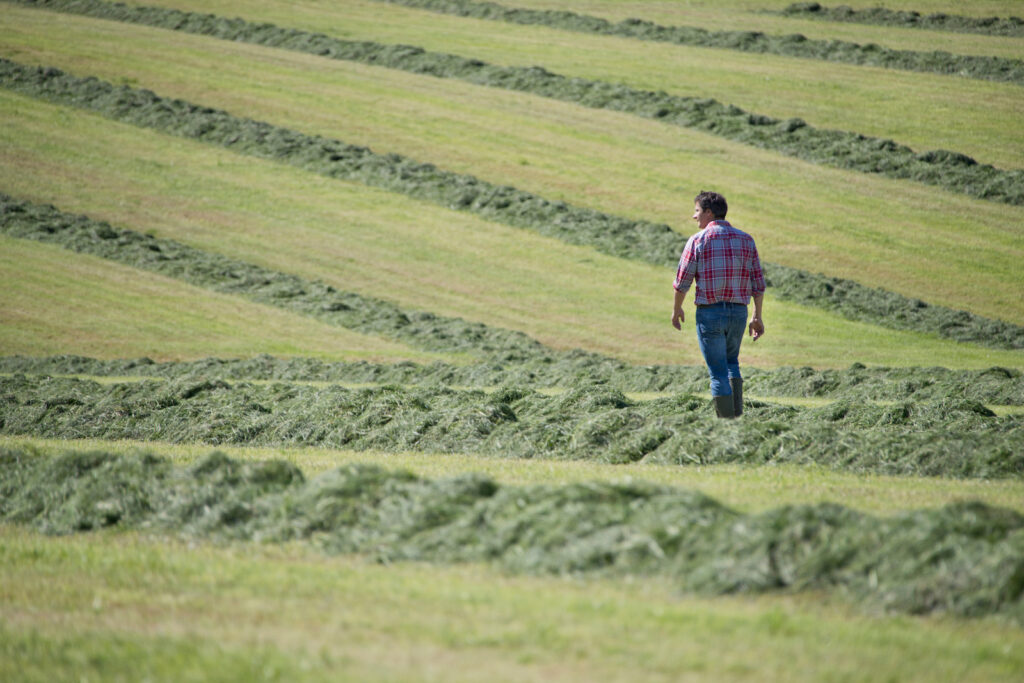It’s not too late for a strategic silage management plan
27th April 2023
A strategic management plan ahead of first cut silage will help farmers make the most of the valuable low-cost crop.

In the latest Mole Valley Farmers’ podcast, nutritionist Dr Robin Hawkey and head of grassland and forage agronomy Lisa Hambly from the farmer cooperative discuss ways farmers can make the most from their grass crop this year. And it all starts with reviewing what happened last year, explained Ms Hambly.
- Review the previous year’s crop
“Think about what was good and bad last year and look at what you can do to plan to overcome those challenges. Different farms will have different requirements for their silage – some will want high quality, whereas others may be focussed on getting more bulk from the crop. Planning over the next couple of weeks will be vital,” she said.
- Test grass pre-cutting
Dr Hawkey suggested farmers test their grass pre-cutting – ideally once or twice a week in the two to three weeks leading up to harvest. “Pre-cutting testing of grass is an easy test and is free as part of the Mole Valley Farmers service. It gives a good indication of where things are going, allowing you to see what the potential of the crop is and also whether adequate nutrients were applied. This means things can be adjusted if needed ahead of subsequent harvests,” he said.
A fertiliser plan will help farmers achieve desired yields, with slurry testing assisting farmers in planning what additional nutrients are needed. Ms Hambly said the starting point was knowing what you want to achieve and then working back on how to achieve it.
- Plan with your contractor and set chop lengths
When using a contractor, it’s important they are on board and are also aware of planned harvest dates. As well as dates, they need to know desired chop length and dry matter (DM).
Dr Hawkey said: “Having a target dry matter will help you plan wilt times. Grass can wilt very quickly, and I have seen some forages achieve 28–30% DM on a decent day in eight hours when the grass is spread effectively and quickly after cutting.
“Deciding the right chop length is also important, depending on what you plan to have in the mix. In general, the drier the silage, the shorter the chop length. Most modern foragers can detect the DM –it’s worth talking to the operator to see if the chop length can be changed ‘on the go’ if required. It’s never too late to make adjustments,” he said.
However, Dr Hawkey warned against cutting too short and being accurate when tedding to avoid contamination.
Ms Hambly said for those with new leys, there’s a greater chance of them having a higher moisture content meaning they could benefit from a longer chop length. However, she warned farmers opting for a longer chop length to plan for extra trailers due to them filling up quicker.
- Consider an additive
Additives are also something farmers should consider and are something Dr Hawkey believes everyone should be using.
“It’s important to select an additive most appropriate for the prevailing conditions. For example, some suit drier or wetter silages and some have an enzyme in them, which can be helpful if taking a bulkier cut as the enzymes help break down the fibre and aid digestion by the animal.
“An additive can also come into its own to help reduce dry matter losses and increase nutrient efficiency of a farm,” he said.
Having a stable clamp and reducing losses from spoilage and runoff also comes down to good clamp management at harvest and sheeting using clingfilm-type sheets to reduce waste.
Dr Hawkey explained the implications poor silage had on one of his client’s herds last year. “One farmer I know estimated his poor silage last year cost him tens of thousands of pounds from lost income because the silage wasn’t correct. Quality is key, and it can cost you a lot if you get it wrong by impacting production and fertility,” he said.
Towards the end of the podcast, the experts discussed weed control post-cutting and options such as overseeding to increase yields.
To listen to the podcast in full visit www.moleonline.com/podcasts
